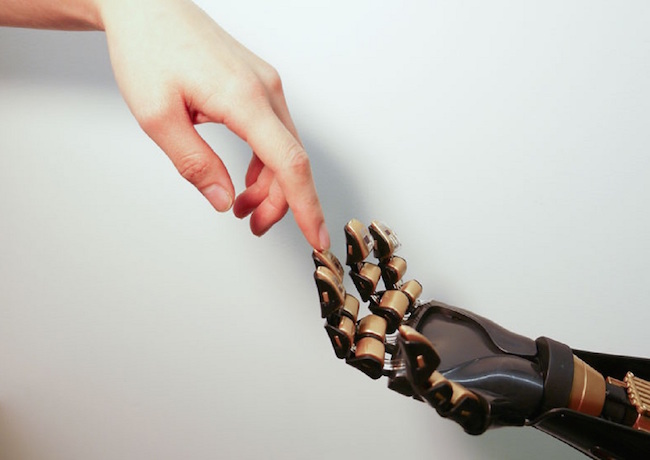Stanford engineers have created a plastic “skin” that can detect how hard it is being pressed and generate an electric signal to deliver this sensory input directly to a living brain cell. The work brings closer the day when a sense of touch is added to prosthetic limbs.
Zhenan Bao, a professor of chemical engineering at Stanford, has spent a decade trying to develop a material that mimics skin’s ability to flex and heal, while also serving as the sensor net that sends touch, temperature and pain signals to the brain. Ultimately she wants to create a flexible electronic fabric embedded with sensors that could cover a prosthetic limb and replicate some of skin’s sensory functions.
Bao’s work, reported Thursday in Science, takes another step toward her goal by replicating one aspect of touch, the sensory mechanism that enables us to distinguish the pressure difference between a limp handshake and a firm grip.
“This is the first time a flexible, skin-like material has been able to detect pressure and also transmit a signal to a component of the nervous system,” said Bao, who led the 17-person research team responsible for the achievement.
WATCH Boy Get New Bionic Arm From ‘Tony Stark’ Himself (Robert Downey Jr.)
Digitizing Touch
The heart of the technique is a two-ply plastic construct: the top layer creates a sensing mechanism that can detect pressure over the same range as human skin, from a light finger tap to a firm handshake. The bottom layer acts as the circuit to transport electrical signals and translate them into biochemical stimuli for nerve cells.
Five years ago, Bao’s team members first described how to use plastics and rubbers as pressure sensors by measuring the natural springiness of their molecular structures. They then indented a waffle pattern into the thin plastic, which adds further springyness.
To exploit this pressure-sensing capability electronically, the team scattered billions of carbon nanotubes through the waffled plastic. Putting pressure on the plastic squeezes the nanotubes closer together and enables them to conduct electricity.
RELATED: Breakthrough Bionic Hand Restores Amputee’s Sense of Touch
The team then hooked this pressure-sensing mechanism to the second ply of their artificial skin, a flexible electronic circuit that could carry pulses of electricity to nerve cells.
Translating to the Cells
Bao’s team has been developing flexible electronics that can bend without breaking. Through a partnership with researchers from PARC, a Xerox company, an inkjet printer was used to deposit flexible circuits onto plastic.
For the electronic signal to be recognized by a living neuron, a technique was used developed by Karl Deisseroth, a Stanford professor of bioengineering, that combines genetics and optics, called optogenetics. They bioengineered cells to make them sensitive to specific frequencies of light, then use light pulses to switch cells on and off from the electronic pressure signals in the artificial skin.
Bao said other methods of stimulating nerves are likely to be used in real prosthetic devices that could replicate, for instance, the ability to distinguish corduroy from silk, or a cold glass of water from a hot cup of coffee.
This will take time. There are six types of biological sensing mechanisms in the human hand, and the experiment described in Science reports success in just one of them. But the current two-ply approach means the team can add sensations as it develops new mechanisms.
“We have a lot of work to take this from experimental to practical applications,” Bao said. “But after spending many years in this work, I now see a clear path where we can take our artificial skin.”
Reprinted (in edited form) with permission from the Stanford News Service – Photo from Bao Labs, Stanford




















